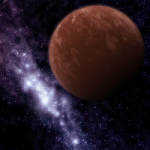Illal is the sixth planet in the Kepler 11 system and is where this struggle for survival takes place.
The Illal system is around 8 billion years old, (twice as old as Earth) and is about 2000 light years from Earth.
The Illal solar system was first surveyed in the middle of the twenty second century, during a time now known as The Great Expansion, by the deep space exploration ship, SNARK.
The discovery of the rare mineral Caverite in the system, secured it a special and important place at the time.
The first people to settle on Illal, found that the atmosphere was un-breathable. As a result, many large atmosphere processing plants were set up to terraform it. These continue to maintain the atmosphere today. They also found some ancient ruins scattered around that date back thousands of years, some of which go deep into the planet. At the moment, no one knows who built them.
Let us start with the star.
At the heart of the Illal system, is it's sun, Kepler-11. Kepler-11 is a sun like star, slightly larger than our Sun, in the constellation of Cygnus, located some 2,000 light years from Earth. Kepler-11 is a G-type star that is approximately 95% the mass of and 110% the radius of the Sun. It has a surface temperature of 5680c and is 8 billion years old, In comparison, the Sun is about 4.6 billion years old and has a surface temperature of 5778c
Below is a layout of the Illal system, to scale.

Below is a diagram to show size comparisons.

Below are some photographs of Illal taken from orbit.





In the image below, is the warm wet region that is an enormous swamp. This area is know as the Namachi Swamplands. It is a treacherous place where many Axes have been lost, sunk in the mire. 
In the image below, you can see the area south of both Prosk and Sentium that contain the Death Lakes. These lakes have been used for several decades by Prosk and Sentium as a dumping ground for all of their toxic waste. The chemicals pumped into the lakes have found there way into the ground water that feeds the Ashihan Forests, located next to the lakes, and has caused some interesting mutations in the plant life. 

As you can see, the surface of the planet has been extensively strip mined, with very few areas left untouched.
Some stats for you.
Illal
Sixth planet from star
Physics
Type: Standard iron/silicate
Radius: 6910.70 km (1.08 x earth)
Surface Area: 6.00 x 108 km2
Land Area: 1.86 x 108 km2 (1.25 x earth)
Mass: 6.61 x 1024 kg (1.11 x earth)
Density: 4.78 g/cm3 (0.87 x earth)
Composition: 34.3% iron, 26.4% oxygen, 18.0% sulphur, 14.1% silicon, 2.9% other metals, 4.4% other elements
Gravimetry
Gravity: 9.20 m/s2 (0.94 x earth)
Escape Velocity: 11.28 km/s
Rotation
Period: 23.75 hours
Hydrosphere
Water: 50 %
Ice: 15 %
Original Atmosphere
Type: Thin toxic
Pressure: 68.60 kPa (0.68 x earth)
Composition: 84.5% carbon dioxide, 15.5% argon, trace other gases
Climate
Type: Cool
Min Temp: 189 K (-83 �C)
Avg Temp: 293 K (20 �C)
Max Temp: 336 K (63 �C)
Civilization
Type: Colony
Original Population: 1.84 Billion
Current Population: 38.77 million
Distance from star 1.05au on the inner edge of the habitable zone
Illal used to be a sub tropical planet covered in dense jungle and desert. Since it was colonised, it has been extensively strip mined. Now, a third of the surface is covered with the Giga Structure and It's atmosphere is just like that of the Earth. It is however, toxic in certain areas where the atmospheric possessors have stopped working because of the Hawken virus.
Many alien artefacts and some ruins have been unearthed during the colonization process. No one knows if these were put here by an indigenous population, or a former colony of some, as yet unknown, alien race.
Although Illal is slightly further from it's star than Earth is to the sun, it's average surface temperature is slightly higher, due to Kepler-11 being slightly larger than the sun. Illal has seasons similar to Earth. This is not because Illal is tilted on it's axis like the Earth. It is because Illal has a slightly elliptical orbit. This means that at certain times, Illal is closer to Kepler 11 and other times it is further away.
Even though Illal is approximately twice as old as Earth, there is still quite a lot of vulconism and tectonic activity. This means earthquakes, active volcanoes, hot springs and other thermal features.
Fennon:


Illal has one moon named Fennon. Fennon is a large moon, slightly smaller in size than Mars, with a similar gravity. It has a thin but breathable atmosphere and has been colonized. A large proportion of the evacuated population of Illal have relocated here. So far it remains virus free.
Fennon has one mega city called Kalisar. The UTA (United Terran Authority) has established a large military base and command and control centre on the outskirts of the city to coordinate the quarantine of Illal. The city is fed by a huge man made reservoir north of the city. There are other, smaller settlements all over the moon. These however, are not visible from orbit.
The lights of Kalisar are visible at night from Illal.
Some stats for you.
Fennon:
Size: Diam 6779km
Mass: 8.70 moons
Orbital Distance: 453604km
Orbital Cycle: 33.4 days
Length of Day: 19hr
The Textures For Illal.
Please note, these are very big illustrations ( 9600x4800 pix 7.87mb)
To view them full size, first left click on the picture. This will take you to Photobucket. Next, click on the magnifier at the top right of the picture. The picture will now fill the screen. Next, right click on the picture and select, view image. Your pointer should turn into a magnifying glass with a plus in it. Left click anywhere on the picture and you will see it full size.
I've posted these so that anyone can use them, including the Dev's if you would like too.
Texture Map Before Virus
Texture Map After Virus
Bump Map
Illuminations Map Before Virus
Illuminations Map After Virus
Specular Map
Edited by SandSpider2, 09 August 2015 - 03:15 PM.
 Sign In
Sign In Create Account
Create Account









 Back to top
Back to top






















































